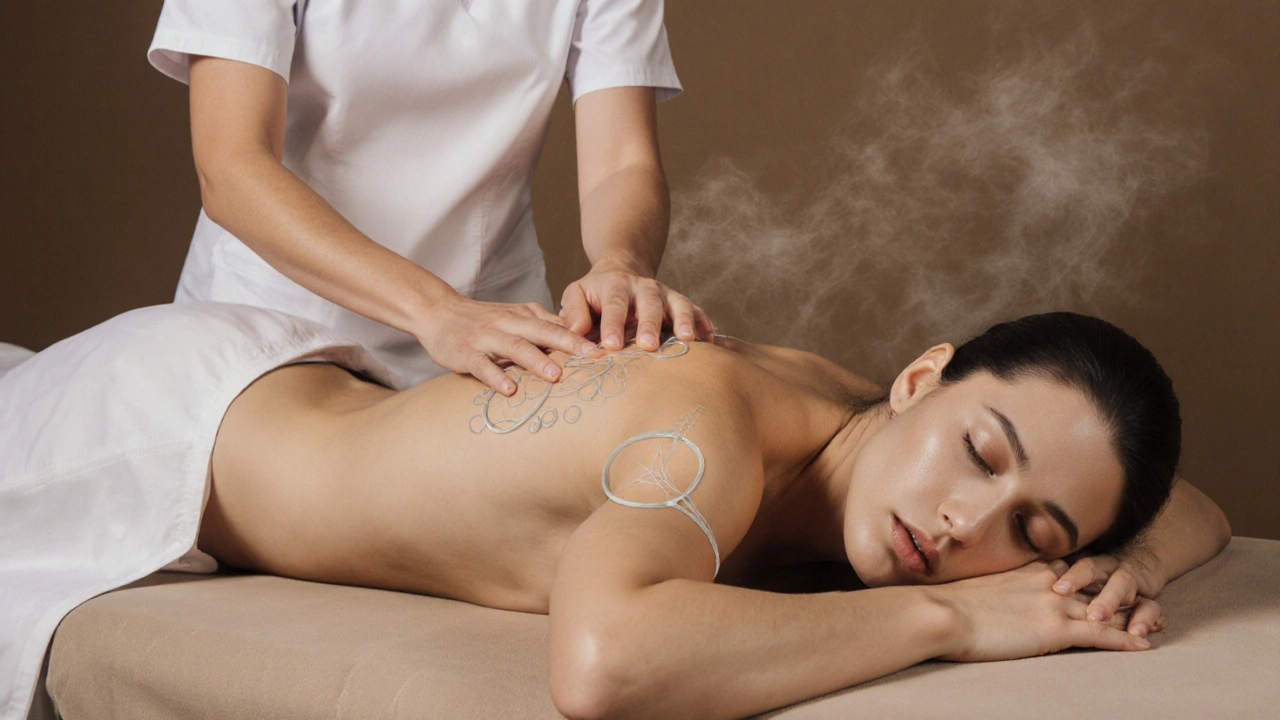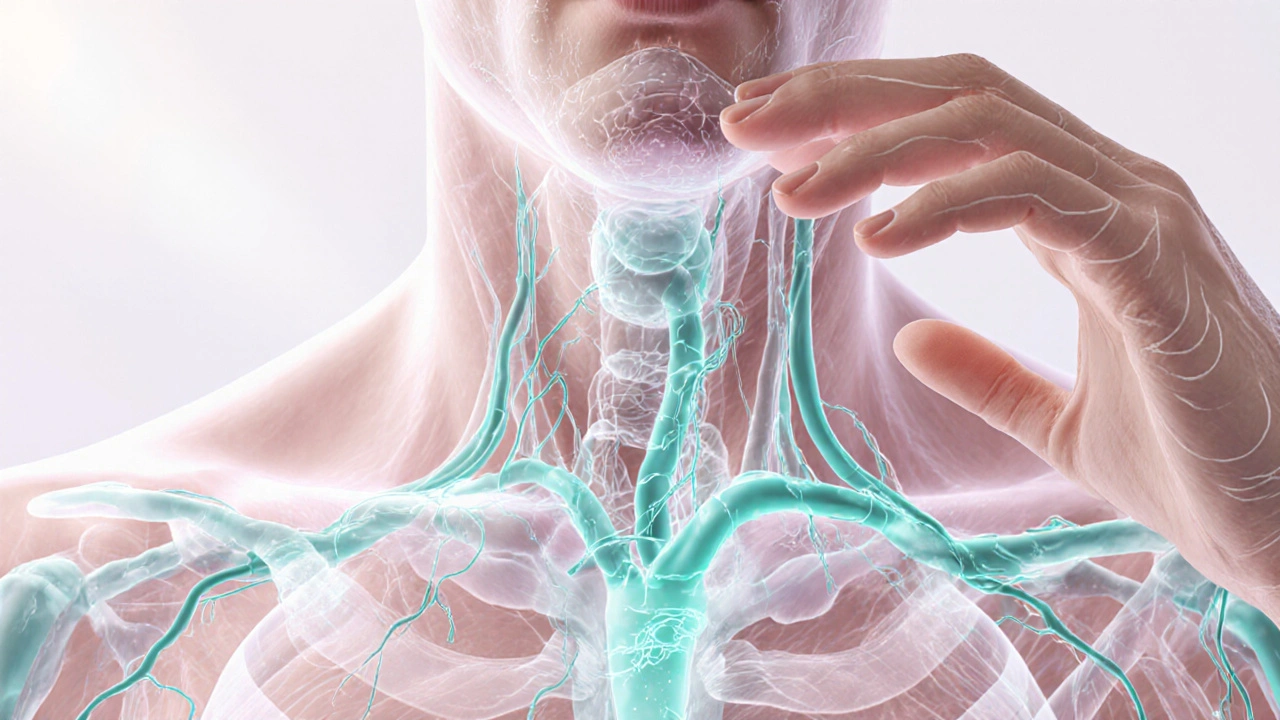Lymphatic Drainage Massage Recommendation Tool
Personalized Guidance
Get tailored recommendations for lymphatic drainage massage frequency based on your health goals and condition.
Recommended Plan
Key Benefits
Important Safety Note
Ever wonder why some people seem to bounce back from illness faster, or why their skin looks smoother after a single session? The answer often lies in a hidden ally called lymphatic drainage massage. This gentle, rhythm‑based therapy moves fluid through the body’s natural waste‑removal highways, helping you feel lighter, clearer, and more resilient.
What Exactly Is Lymphatic Drainage Massage?
When you hear the term Lymphatic Drainage Massage is a light, hands‑on technique designed to stimulate the flow of lymph- the clear fluid that transports immune cells and carries out waste removal . It isn’t about deep pressure or muscle kneading; instead, the therapist uses very soft, rhythmic strokes that follow the body’s natural lymph pathways.
How the Lymphatic System Works
The Lymphatic System is a network of vessels, nodes, and organs that collects excess fluid, filters out toxins, and supports immune surveillance. Unlike the circulatory system, it doesn’t have a central pump; it relies on muscle movement, breathing, and external stimulation to keep lymph moving. When this flow slows, fluid can pool, leading to Edema - swelling caused by excess interstitial fluid, and the immune system may struggle to detect threats efficiently.
Core Techniques and Stroke Patterns
Therapists typically follow three basic motions:
- Stationary circles: Small, circular movements over lymph nodes (e.g., neck, armpits, groin) to encourage fluid entry.
- Pump strokes: Light, pushing motions that follow the direction of lymph vessels toward the nearest node.
- Sweep strokes: Gentle, sweeping gestures that clear the superficial pathways.
These motions mirror the body’s own “peristaltic” action, and they’re performed with just enough pressure to feel like a soft brush on the skin.

Health Benefits Backed by Evidence
Research and clinical observation point to several concrete advantages:
- Reduced swelling: A 2019 study of post‑surgical patients showed a 30% faster loss of limb volume when Manual Lymphatic Drainage (MLD) was added to standard care.
- Improved immune response: Regular sessions increase the circulation of lymphocytes, which helps the body spot and neutralize pathogens more quickly.
- Detoxification: By moving stagnant fluid, the technique assists the removal of metabolic waste, supporting clearer skin and reduced cellulite appearance.
- Pain relief: Swollen tissues press on nerves; easing that pressure can lower chronic pain levels, especially in conditions like fibromyalgia.
- Enhanced recovery: Athletes report quicker muscle recovery because excess lactate and inflammatory mediators are cleared more efficiently.
While the therapy isn’t a cure‑all, the cumulative effect of better fluid dynamics often translates into a noticeable boost in overall vitality.
Who Should Try It and Who Should Avoid
Ideal candidates include:
- People dealing with chronic edema or lymphedema after lymph node removal.
- Those recovering from surgery, especially orthopedic or cosmetic procedures.
- Individuals with autoimmune flare‑ups who need gentle support for the immune system.
- Anyone looking for a natural way to reduce bloating, cellulite, or post‑exercise soreness.
Contra‑indications (situations to skip the treatment) are equally important:
- Active infections or fever - stimulating lymph flow could spread pathogens.
- Blood clots or deep vein thrombosis - increased circulation may dislodge clots.
- Cancer patients undergoing chemotherapy without doctor clearance - some oncologists advise caution.
- Severe heart failure - the extra fluid shift could overload the heart.
Always discuss your health history with a qualified therapist before the first session.

Comparison with Other Popular Massages
| Feature | Lymphatic Drainage Massage | Swedish Massage | Deep Tissue Massage |
|---|---|---|---|
| Primary Goal | Stimulate lymph flow & reduce fluid retention | Relax muscles & improve circulation | Release deep muscle tension & knots |
| Pressure Level | Very light (1‑2 on a 10‑point scale) | Medium (3‑5) | Firm to deep (6‑9) |
| Typical Session Length | 45‑60 minutes | 60‑90 minutes | 60‑90 minutes |
| Contra‑indications | Infection, clotting disorders, uncontrolled cancer | Skin wounds, acute inflammation | Bone fractures, severe varicose veins |
| Best For | Swelling, lymphatic health, post‑surgical recovery | Stress relief, general wellbeing | Chronic muscle pain, sports injuries |
Seeing the table side‑by‑side helps you decide which massage aligns with your goals. If you’re after detox, reduced puffiness, or a gentle immune boost, Lymphatic Drainage Massage stands out.
Getting the Most Out of a Session - Practical Tips
- Hydrate before and after: Water helps move the newly mobilized lymph through the system.
- Wear loose clothing: Tight garments can restrict lymph flow, undoing the therapist’s work.
- Combine with gentle movement: Light walking or yoga after the massage keeps the fluid moving.
- Ask about self‑care techniques: Simple skin‑rolling or diaphragmatic breathing can extend benefits.
- Schedule regular visits: A series of 5‑7 sessions spaced a week apart often yields the best results.
Frequently Asked Questions
How often should I get lymphatic drainage massage?
For most people, a weekly session for the first month, followed by a maintenance schedule of once every two to three weeks, works well. Those with chronic swelling may benefit from more frequent visits under professional guidance.
Can I do lymphatic drainage massage on myself?
Self‑massage can help between professional sessions, but it requires training to avoid pulling the skin or using too much pressure. Simple hand‑over‑the‑area sweeps and gentle neck circles are safe starting points.
Is the massage painful?
No. The strokes are intentionally light, comparable to a gentle brush against the skin. If you feel discomfort, tell the therapist to adjust the pressure.
What’s the difference between manual lymphatic drainage and the massage I’m reading about?
Manual Lymphatic Drainage (MLD) is the formal name for the technique; it follows a specific sequence of strokes based on anatomical research. The term “lymphatic drainage massage” is the broader, consumer‑friendly label, but both refer to the same therapeutic approach.
Will this massage help with cellulite?
Many clients notice smoother skin after a series of sessions because improved lymph flow reduces fluid buildup and encourages healthier fat metabolism. Results vary, and combining the massage with proper nutrition and exercise maximizes benefits.


 Health and Wellness
Health and Wellness